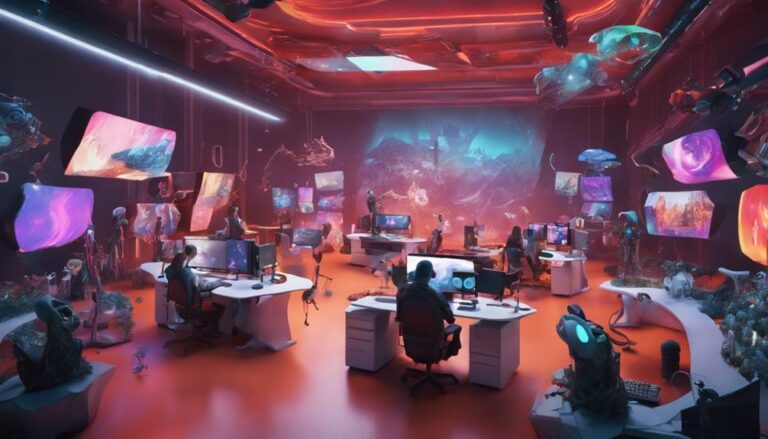Why Do Video Game Trailers Rely on CGI Effects?
You've likely noticed that video game trailers often rely heavily on CGI effects to create an immersive experience. But have you ever stopped to think why developers opt for CGI over in-game footage? It's more than just a flashy way to grab your attention. By leveraging CGI, developers can craft a specific emotional response, evoke a sense of nostalgia, and set the tone for their game. But what are the limitations of in-game footage that make CGI a more appealing choice? And how do these effects shape your expectations for the game itself?
Key Takeaways
- Video game trailers rely on CGI effects to establish atmosphere and mood, drawing viewers into the game's world and evoking emotions.
- CGI helps craft a specific emotional response, whether it's excitement, fear, or wonder, setting the stage for the rest of the trailer.
- In-game footage limitations, such as graphics overload and polycount reduction, make CGI a more viable option for showcasing a game's full potential.
- CGI effects allow for rapid iterations and adjustments, giving developers greater creative control over trailer visuals without budget or logistical constraints.
Setting the Tone With CGI
When watching a video game trailer, you're often immediately immersed in the game's atmosphere, and that's largely due to the strategic use of CGI effects to set the tone from the very start.
The clever application of computer-generated imagery helps establish the mood and craft the atmosphere, drawing you in and making you want to learn more.
By using CGI, trailer creators can craft a specific emotional response, whether it's excitement, fear, or wonder.
This mood establishment is vital, as it sets the stage for the rest of the trailer and shapes your expectations for the game.
Effective atmosphere crafting can transport you to a fantastical world, put you in the midst of an epic battle, or even evoke a sense of nostalgia.
By leveraging CGI, trailer makers can create a rich, immersive experience that leaves a lasting impression.
As a result, you're more likely to remember the game and anxiously anticipate its release.
In-Game Footage Limitations
As you watch a video game trailer, you might assume that the in-game footage will live up to the hype, but you'll often find that it doesn't quite measure up.
This isn't because the developers are lazy, but rather because there are technical limitations that come with recreating those impressive scenes in real-time gameplay.
You'll soon discover that graphics overload woes, limited camera angles, and the battle between realism and optimization all play a role in shaping your in-game experience.
Graphics Overload Woes
You've likely noticed that some video game trailers boast incredibly detailed graphics, only to have the actual in-game experience fall short, and this disparity is largely due to the limitations of in-game footage.
One major issue is Visual Overload, where games try to pack too much detail into every scene, resulting in a messy and cluttered visual experience. This can lead to Technical Debt, where the game's performance suffers due to the strain on resources.
| Issue | Impact |
|---|---|
| Limited Polycount | Reduced detail in characters and environments |
| Insufficient Lighting | Unrealistic and unimmersive lighting |
| Over-Optimization | Poor performance and framerate drops |
| Inconsistent Art Style | Jarring visual inconsistencies |
To avoid these issues, developers must strike a balance between visual fidelity and performance. By prioritizing the most important graphical elements and optimizing their code, they can create a more cohesive and enjoyable gaming experience.
Limited Camera Angles
Limited camera angles severely restrict the visual storytelling potential of in-game footage, forcing developers to rely heavily on CGI trailers to showcase their game's most epic moments.
When you're playing a game, you're limited to the camera angles and movements programmed by the developers. This can make it difficult to capture the same level of drama and excitement that a CGI trailer can achieve with its flexibility in camera placement and movement.
These camera constraints can be a major hurdle when trying to create engaging in-game footage. For instance, you mightn't be able to get a clear shot of an explosion or a dramatic character moment due to angle limitations.
This is where CGI trailers come in, allowing developers to create a more cinematic experience with the freedom to experiment with different camera angles and movements. By leveraging CGI, developers can create a more immersive and mesmerizing trailer that showcases their game's most thrilling aspects, which mightn't be possible with in-game footage alone.
Realism Vs. Optimization
When attempting to record in-game footage, you're often forced to choose between realism and optimization, as the pursuit of graphical fidelity can result in performance issues that hinder the overall gaming experience.
This dilemma arises because in-game engines struggle to maintain high frame rates while rendering complex graphics.
To compensate, developers may take artistic liberties, sacrificing realism for the sake of smooth gameplay.
Frame rate drops: When the game's engine can't handle the graphics, frame rates plummet, leading to choppy gameplay and an unimmersive experience.
Downgraded graphics: To maintain performance, developers might reduce graphical quality, compromising on realism to guarantee a smoother experience.
Limited camera angles: You might notice that camera angles are restricted or cinematic, allowing the engine to focus on rendering specific elements rather than the entire environment.
The Cost of Realism
Many developers are finding that their pursuit of realistic graphics in video game trailers comes at a steep price, with costs skyrocketing into the millions of dollars.
As you explore further into the world of video game development, you'll realize that the drive for realism is often at odds with budget constraints.
The pressure to deliver stunning visuals can lead to a significant blow to your wallet.
When it comes to creating a visually stunning trailer, your artistic vision might be compromised by the limitations of your budget.
You might need to make some tough decisions, like scaling back on the number of CGI effects or reducing the trailer's length.
This can be a difficult pill to swallow, especially if you've invested a lot of time and effort into crafting a compelling narrative.
However, finding a middle ground is crucial to strike a balance between your artistic vision and the financial realities of game development.
CGI's Flexibility Advantage
By leveraging CGI effects, you can exercise greater creative control over your trailer's visuals, allowing for rapid iterations and adjustments that would be impractical or impossible with live-action footage. This flexibility gives you the artistic freedom to experiment with different visual styles, tone, and atmosphere, ensuring your trailer accurately represents the game's essence.
Unlimited visual experimentation: With CGI, you can try out radical concepts, test bold ideas, and push the boundaries of what's possible without worrying about budget or logistical constraints.
Quick turnaround and revisions: Need to make last-minute changes or updates? CGI allows you to do so rapidly, ensuring your trailer stays on track and meets your vision.
Total control over every detail: From character designs to environmental textures, CGI gives you complete dominion over every visual aspect, ensuring consistency and cohesion throughout your trailer.
Creating the Perfect Narrative
As you craft a video game trailer, you'll want to focus on creating a narrative that draws viewers in and keeps them invested.
You'll need to strike the right balance between visual storytelling and emotional connection, making sure your trailer conveys the essence of your game without giving too much away.
Vivid Visual Storytelling
Crafting a compelling narrative in video game trailers relies on vivid visual storytelling, which transports viewers into the game's world and makes them invested in its characters and storyline. As you watch a trailer, you're not just passively observing – you're actively engaged, piecing together the narrative threads and anticipating what's to come.
This immersion is achieved through a combination of techniques that create a rich, cinematic experience.
Visual metaphors use imagery to convey complex themes or emotions, adding depth to the narrative without explicit exposition.
Dynamic pacing shifts between fast-paced action and quiet, introspective moments to create a sense of tension and release.
Environmental storytelling uses the game's environment to reveal clues about the world, its history, and the characters that inhabit it.
Emotional Connection Established
You're drawn into the narrative when a trailer establishes an emotional connection, making you invested in the characters' struggles and triumphs.
This emotional resonance is vital in creating a lasting impression, and CGI effects can play a significant role in achieving it.
By using CGI to bring characters to life, developers can create a deeper sense of character development, making you care about their fate.
When you see a character's facial expressions, body language, and interactions with their environment, you start to form a bond with them.
This emotional connection is further amplified when the trailer's narrative is well-crafted, with a clear structure, pacing, and tone that resonates with the game's themes.
As a result, you become invested in the story, enthusiastic to learn more about the characters and their journey.
Player Expectations and Hype
When a video game trailer drops, it sets your expectations soaring, creating an emotional investment that can sometimes make the final product feel underwhelming if it doesn't meet the hype. You start imagining the thrilling gameplay, stunning visuals, and epic storylines, and you can't help but feel excited.
However, this hype can be a double-edged sword. If the final game doesn't live up to the trailer's promises, you might feel disappointed or even betrayed.
To manage these expectations, game developers and marketers need to walk a fine line between generating hype and setting realistic expectations.
Hype management is pivotal: Developers should aim to create a buzz around their game without overpromising and underdelivering.
Marketing strategy matters: A well-thought-out marketing strategy can help set realistic expectations and build trust with the gaming community.
Transparency is key: Developers should be open about what their game can and can't deliver, avoiding misleading or deceptive marketing tactics.
Technical Challenges of In-Game
Implementing CGI effects in-game poses significant technical challenges, as developers must balance visual fidelity with performance, guaranteeing that the game runs smoothly on a wide range of hardware configurations.
You'll quickly realize that incorporating CGI elements into gameplay is a complex task. For instance, pixel constraints and rendering limitations can hinder the quality of CGI effects, making them appear less realistic or even cartoonish.
Furthermore, developers must consider the processing power of various gaming platforms, from high-end PCs to lower-end consoles, to guarantee a consistent gaming experience.
Additionally, you'll encounter issues with asset optimization, where developers must compress and optimize CGI assets to fit within the game's memory constraints.
This can lead to a trade-off between visual quality and performance, forcing developers to make difficult decisions about what to prioritize.
As a result, it's often more practical to reserve CGI effects for cinematic cutscenes or pre-rendered sequences, where they can be showcased without compromising gameplay performance.
Showcasing Gameplay Without Gameplay
Video game trailers often cleverly showcase gameplay without actually featuring gameplay, instead relying on CGI effects to create an immersive and engaging experience that sets the tone for the game. Well, it's all about clever storytelling and visual manipulation.
Cutscenes masquerading as gameplay: By using CGI effects to create cinematic cutscenes that mimic gameplay, trailers can create the illusion of action-packed gameplay without actually showing any real gameplay.
Game demos that aren't really demos: Sometimes, trailers will show what appears to be a game demo, but it's actually a scripted sequence designed to showcase specific features or mechanics.
Virtual prototypes: Developers might create virtual prototypes of gameplay sequences to test and refine their ideas, and then use these prototypes in trailers to give a glimpse into the game's potential.
Frequently Asked Questions
Do Video Game Developers Use CGI to Deceive Players About Gameplay?
You wonder if video game developers use CGI to deceive players about gameplay. Honestly, it's often a marketing tactic to create unreal expectations, leaving you disappointed when the actual game doesn't live up to the trailer's hype.
Can In-Game Footage Be Used for Trailers Without Spoiling the Game?
You can create engaging trailers using in-game footage without spoiling the game by focusing on ideal pacing and strategically placed gameplay teases that build anticipation without revealing too much.
Are CGI Trailers More Expensive Than Live-Action Trailers?
You're wondering if CGI trailers are more expensive than live-action ones? Generally, CGI trailers are more cost-effective, as they bypass location scouting and actor fees, but industry standards and budget constraints can influence final costs.
Why Don't Game Developers Use CGI for the Entire Game?
You might wonder why game developers don't use CGI for the entire game. Technical limitations, like processing power and memory constraints, hold them back. Additionally, their artistic vision often requires a more dynamic, interactive experience that CGI alone can't deliver.
Do CGI Trailers Accurately Represent the Game's Story and Tone?
When watching a CGI trailer, you wonder if it accurately represents the game's story and tone. Unfortunately, it often doesn't, creating a mismatch between your visual expectations and the actual gameplay experience, compromising story authenticity.
Conclusion
You've seen the impact of CGI in video game trailers – the breathtaking visuals, the immersive atmosphere, and the unforgettable emotional responses.
By leveraging CGI, developers can craft a rich, engaging experience that leaves you wanting more.
From setting the tone to showcasing gameplay without in-game footage, CGI offers unparalleled creative control, flexibility, and realism.
The result? Trailers that not only hype players but also accurately represent the game's vision, making CGI an indispensable tool in the world of video game marketing.





